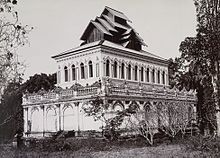Kalyani Ordination Hall
| Kalyani Ordination Hall | |
|---|---|
ကလျာဏီသိမ် | |
 The Kalyani Ordination Hall in 1907 | |
| Religion | |
| Affiliation | Buddhism |
| Sect | Theravada Buddhism |
| Region | Bago Region |
| Year consecrated | 24 November 1476 9th waxing of Nadaw 838 ME |
| Location | |
| Municipality | Bago |
| Country | Myanmar |
| Geographic coordinates | 17°19′59″N 96°27′52″E / 17.333145°N 96.464378°E |
| Architecture | |
| Founder | Dhammazedi |
| Completed | 22 November 1476[note 1] 7th waxing of Nadaw 838 ME |
Kalyāṇī Ordination Hall (Burmese: ကလျာဏီသိမ်, Pali: Kalyāṇī Sīmā) is a Buddhist ordination hall located in Bago, Myanmar. The ordination hall is a major pilgrimage site,[1] and houses the Kalyani Inscriptions, a set of 10 sandstone pillars inscribed in Pali and Mon in 1480.[2][3] The inscriptions are important records of Theravada history of Buddhism and of that era.[3]
History
[edit]The ordination hall was first built by King Dhammazedi of the Hanthawaddy Kingdom in 1476 to re-ordain the kingdom's Buddhist monks, in an effort to purify the kingdom's Sangha, which had undergone several internal schisms.[4] To this end, in 1476, Dhammazedi sent 22 senior monks and their disciples to Sri Lanka, where they were re-ordained at the Kelaniya Raja Maha Vihara.[4] After the monks had returned, Dhammazedi built the Kalyani Ordination Hall, which derives its name from the Kelani River in Sri Lanka.[5][4] The construction of the first Kalyani Ordination Hall spurred construction of similarly-named Kalyani Ordination Halls; throughout the Hanthawaddy Kingdom, 9 large ones and 107 small ones were constructed.[5]
The ordination hall was destroyed several times. Portuguese explorers burnt the structure in 1599, and King Alaungpaya destroyed the hall during his invasion of Bago in 1757.[4][6] The ordination hall was also destroyed by fires and earthquakes, including an earthquake in 1930 that levelled the structure completely.[6] The extant ordination hall was reconstructed in 1954.[4]
Notes
[edit]- ^ (Taw 1892: 92): Construction of the ordination hall was completed on Saturday [sic], the 7th waxing of Migasira (Nadaw) 838 ME (Friday, 22 November 1476); King Dhammazedi visited the hall on the 8th waxing (23 November 1476); and the hall formally received the name Kalyani Sima, and per (Taw 1892: 95, 97) hosted the first re-ordination ceremony on the 9th waxing (24 November 1476).
References
[edit]- ^ Carbine, Jason A. (2011). Sons of the Buddha: Continuities and Ruptures in a Burmese Monastic Tradition. Walter de Gruyter. ISBN 9783110254105.
- ^ Ring, Trudy; Watson, Noelle; Schellinger, Paul (2012). Asia and Oceania: International Dictionary of Historic Places. Routledge. ISBN 9781136639791.
- ^ a b South, Mr Ashley (2013). Mon Nationalism and Civil War in Burma: The Golden Sheldrake. Routledge. ISBN 9781136129544.
- ^ a b c d e De Thabrew, W. Vivian (2014). Buddhist Monuments And Temples Of Myanmar And Thailand. AuthorHouse. ISBN 9781491896228.
- ^ a b Chaturawong, Chotima; Weerakoon, Tawan; Yasi, Pongpon (2018-06-25). "Ayutthaya and Burma". NAJUA: Architecture, Design and Built Environment. 33: A27 – A54. ISSN 2697-4665.
- ^ a b Wright, Colin (26 March 2009). "Kalyani Sima, [Pegu]". British Library. Retrieved 2016-11-28.
Bibliography
[edit]- Sein Ko Taw (1892). The Kalyani Inscriptions Erected by King Dhammaceti at Pegu in 1476 A.D. Text and Translation (PDF). Rangoon: The Superintendent, Government Printing, Burma.

